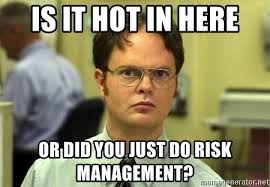Risk Management Program Discussion Questions
Follow the links below to access other assignment solutions for this course
Week 1 Assignment: Elements of a Risk Management Program
Week 2 Assignment: Risk Management Assessment
Week 4 Assignment: Organizational Risk Management Interview
Instructions:
Response to each question is approximately 250-500 words with 1 or 2 references
Week 1 Discussion Question 1:
The American Society of Healthcare Risk Management (ASHRM) has outlined the minimal components of a risk management program. Describe a minimum of three of those elements and evaluate if the elements are present in your organization’s risk management program, or describe how they can be included in a risk management program of a health care organization. In addition, provide examples with one peer-reviewed reference to support your response.
Week 1 Discussion Question 2:
Briefly describe how your organization’s risk management program (or a health care organization) could addresses social media and patient information privacy. Provide three examples and support your analysis with one peer-reviewed reference.
Solution

Response to Question 1
The first American Society of Healthcare Risk Management (ASHRM) proposed minimal component of a risk management program requires that there be an experienced and trained designated risk manager in the hospital setting, who undergoes continuing education, obtaining a minimum of eight hours annually (Kavaler & Alexander, 2014). This is an important component as it aims and ensuring efficiency and professionalism in the risk management process, given that the nature of risks within the healthcare system is evolving. Such an individual can be incorporated within the program through a proper recruitment and selection process that will determine competencies and efficiency of each applicant, before coming up with the best practitioner. Another component requires that necessary resources be committed by the institution to the management of risk via a written policy statement, which is to be adopted by the medical staff, governing body, and administration (Kavaler & Alexander, 2014). This can be achieved through proper allocation of risk management funds during budgeting and establishing a risk management financial management wing that will ensure that they have the necessary resources required to carry out their function. A third component requires the organization to have a method through which all risk management data can be centralized, and through which data collection and analysis can be integrated and shared with other administrative and clinical departments (Kavaler & Alexander, 2014). This can be incorporated into the program through the establishment of a central database for risk management data and adopting IT technology that would ensure that all important risk management information is disseminated to the health care professionals to create awareness and improve care quality. The system should also allow for sharing of safety information among the health professionals.
Response to question 2
If not well managed,
social media could be dangerous to both health professionals and the health
care organizations. As such, it is upon the risk management program to ensure
that patient privacy is protected in social interactions of the health
personnel. One of the methods through which such can be achieved is by
establishing social media use guidelines for the health professionals, which
will ensure that they understand their scope of use of the social networks and
the kind of information that they can share on such networks (Ventola,
2014).
An example of such guidelines is what has been developed by the National
Council of State Board of Nursing, which defines the dos and don’ts of social
networking for nurses. The risk management program should address the risk of
social media use through establishing employee policies that encompass
harassment, discrimination, leaking of proprietary or confidential information,
damaging of the reputation of the organization, and issues of productivity.
This would ensure that health personnel understand their required conduct and
that violators of the policies are punished accordingly. On the other hand, the
program could establish policies regarding disciplinary actions that could be
taken in response to the use of cellphones, tablets, or the internet during
working hours (Ventola, 2014). Such policies could
come in handy in terms of minimizing concerns related to posting of patient
information or pictures online, which could lead to violation of the state or
federal privacy laws. The program could also establish a policy that would
require the medical professionals to sign HIPAA authorization prior to posting
specific patient information on social media (Ventola, 2014). This would allow
for proper monitoring of the kind of information that is shared on social
media.
References
Kavaler, F., & Alexander, R. S. (2014). Risk Management in Health Care Institutions: Limiting Liability and Enhancing Care (3rd ed.). https://www.google.com/books/edition/Risk_Management_in_Healthcare_Institutio/UPiaXsSIoJAC?hl=en&gbpv=0
Burlington, MA: Jones and Bartlett Learning. Ventola, C. L. (2014). Social Media and Health Care Professionals: Benefits, Risks, and Best Practices. Pharmacy and Therapeutics, 39(7), 491-499. https://www.ncbi.nlm.nih.gov/pmc/articles/PMC4103576/

